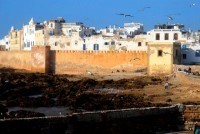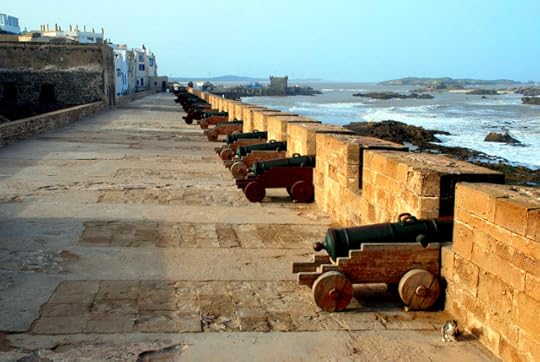Essaouira: fortifications and architecture, Day 246
Sadly, this is our last full day in Essaouira. We have been here for 6 days and a wonderful sense of contentment has set in, which is a serious danger for travelers. Perhaps one of the key elements of traveling in a foreign land is that you are always uncomfortable because you are always getting lost and you don’t know how things work. By the time you’ve figured out these basic issues for each destination it’s usually time to move on and become uncomfortable all over again. I think the art of traveling is to make oneself comfortable in uncomfortable situations. And if you can’t do that then you’re probably not going to enjoy this type of adventure on a repeat basis. Is it possible that the reason Christi and I return to the Open Road on such a regular basis is that we get too comfortable in our daily lives? And such is the level of our contentment here in Essaouira that we barely make it to the rooftop terrace before the breakfast service ends at 10:30 am. Today, Christi and I are going our separate ways – at least for a few hours. Christi’s maniacal dedication towards uploading the hundreds of photos I’ve taken of late take to Picassa is very impressive. Perhaps less impressive from Christi’s perspective is that I’m going to spend another day photographing the medina and its surrounding fortifications.
The medina is a UNESCO world heritage listed city. It is an example of a late 18th century fortified town, built by European colonists. Frenchman, Thédore Cornut, designed and built most of the city (including the northern fortifications or ‘scala’), while the harbor entrance was built by an English renegade known as Ahmed the English (and no I’m not making that up) and the harbor citadel (or southern scala) was built by Genoese engineers. In addition to the fortifications, themselves, cannons (some of which are Dutch and date to 1744) still guard the city. It is remarkable to think that as recently as 1956 Essaouira was part of the French Protectorate of Morocco. Even now there are enclaves within Morocco – namely Ceuta and Melilla on the Mediterranean coast – that are administered by Spain.
Later, I rescue Christi from the internet cafe and show her some of the fortifications in the harbor and in the medina itself. In truth, though, she’s more excited by the dogs and cats we find. It’s been a great few days here in Essaouira but tomorrow we move on to the brashness of Marrakesh. Christi and I will miss this little slice of heaven by the sea.








Blog post by Roderick Phillips, author of Weary Heart – a gut-wrenching tale of love and test tubes.
The post Essaouira: fortifications and architecture, Day 246 appeared first on Roderick Phillips.




